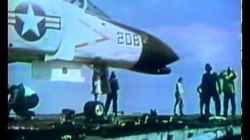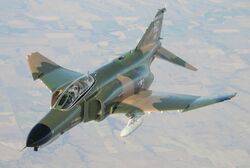
A US Air Force F-4 flies with the 82d Aerial Targets Squadron over White Sands Missile Range.
Data[]
| Category. | Statistic. |
|---|---|
| First flight on. | 1958. |
| Retired on. | Yes. 2013 (German Air Force). |
| Major contractor(s). | McDonnell Douglas. |
| Dose it use nukes or cruse missiles. | Yes. The B28EX, B61, B43 and B57 atomic bombs. |
| Fight ceiling. | 60,000 ft (18,300 m). |
| Top speed. | Maximum speed: Mach 2.23 (1,472 mph, 2,370 km/h) at 40,000 ft (12,190 m). |
| VTOL. | No. |
| Range | Ferry range: 1,403 nmi (1,615 mi, 2,600 km) with 3 external fuel tanks. |
| Crew. | 2. |
| Nationality(s). | American. |
| Class. | Interceptor fighter and fighter-bomber. |
| Rate of climb. | Rate of climb: 41,300 ft/min (210 m/s). |
| Links. | http://www.wikiwand.com/en/McDonnell_Douglas_F-4_Phantom_II, http://web.archive.org/web/20071228023628/http://www.janes.com/defence/news/jdi/jdi070321_1_n.shtml, http://www.flightglobal.com/news/articles/japan-likely-to-choose-f-35-for-f-x-requirement-reports-365971, http://www.f-4.nl/f4_13.html, http://www.f-4.nl/f4_14.html and http://the-diplomat.com/flashpoints-blog/2011/12/14/japan-chooses-f-35/. |
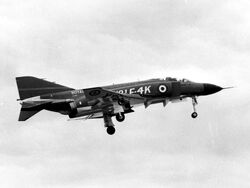
The first British Phantom lands at the McDonnell plant in St Louis, Missouri in 1966.
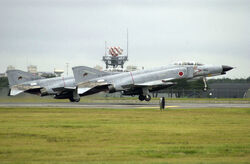
A pair of F-4EJs with their new air superiority paint scheme.
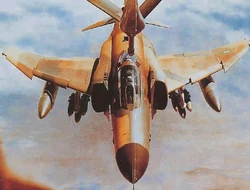
Iranian Phantom refueling through a boom during Iran-Iraq war.
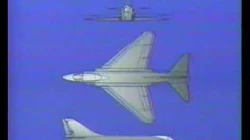
McDonnell Douglas F-4 Phantom II-1
The McDonnell Douglas F-4 Phantom II is a two-seat, twin-engined, all-weather, long-range supersonic interceptor fighter/fighter-bomber originally developed for the U.S. Navy by McDonnell Aircraft. Proving highly adaptable, it became a major part of the air wings of the U.S. Navy, U.S. Marine Corps, and U.S. Air Force. It was used extensively by all three of these services during the Vietnam War, serving as the principal air superiority fighter for both the Navy and Air Force, as well as being important in the ground-attack and reconnaissance roles by the close of U.S. involvement in the war.
History[]
Development[]
The F-4J had improved air-to-air and ground-attack capability; deliveries begun in 1966 and ended in 1972 with 522 built. It was equipped with J79-GE-10 engines with 17,844 lbf (79.374 kN) thrust, the Westinghouse AN/AWG-10 Fire Control System (making the F-4J the first fighter in the world with operational look-down/shoot-down capability), a new integrated missile control system and the AN/AJB-7 bombing system for expanded ground attack capability.
In 1972, the F-4E model was upgraded with leading edge slats on the wing, greatly improving high angle of attack maneuverability at the expense of top speed.
The F-4N (updated F-4Bs) with smokeless engines and F-4J aerodynamic improvements started in 1972, under a U.S. Navy-initiated refurbishment program called "Project Bee Line" with 228 converted by 1978.
In addition to the loss of performance due to drag, combat showed the externally mounted cannon to be inaccurate unless frequently boresighted, yet far more cost-effective than missiles. The lack of a cannon was finally addressed by adding an internally mounted 20 mm (.79 in) M61A1 Vulcan on the F-4E.
Later models incorporated a M61 Vulcan rotary cannon.
Major exports[]
The Israeli Air Force was the largest foreign operator of the Phantom, flying both newly built and ex-USAF aircraft, as well as several one-off special reconnaissance variants. The first F-4Es, nicknamed "Kurnass" (Sledgehammer), and RF-4Es, nicknamed "Orev" (Raven), were delivered in 1969 under the "Peace Echo I" program. Additional Phantoms arrived during the 1970s under "Peace Echo II" through the "Peace Echo V" and "Nickel Grass" programs. Israeli Phantoms saw extensive combat during Arab–Israeli conflicts, first seeing action during the War of Attrition. In the 1980s, Israel began the "Kurnass 2000" modernization program which significantly updated avionics. The last Israeli F-4s were retired in 2004.
From 1968, the Japan Air Self-Defense Force purchased a total of 140 F-4EJ Phantoms without aerial refueling, Bullpup ASM system, nuclear control system and ground attack capabilities. Mitsubishi built 138 under license in Japan and 14 unarmed reconnaissance RF-4Es were imported. Of these, 96 F-4EJs have since been modified to the F-4EJ Template:Nihongo standard. 15 F-4EJs were converted to reconnaissance aircraft designated RF-4EJ, with similar upgrades as the F-4EJ Kai. Japan had a fleet of 90 F-4s in service in 2007. It has been studying several replacement fighters.
In the 1960s and 1970s when the U.S. and Iran were on friendly terms, the U.S. sold 225 F-4D, F-4E, and RF-4E Phantoms to Iran. Notable operations of Iranian F-4s during the war included Operation Scorch Sword, an attack by two F-4s against the Iraqi Osirak nuclear reactor site near Baghdad on 30 September 1980, and the attack on H3, a 4 April 1981 strike by eight Iranian F-4s against the H-3 complex of air bases in the far west of Iraq, which resulted in many Iraqi aircraft being destroyed or damaged for no Iranian losses.
Two variants were initially built for the UK: the F-4K variant was designed from the outset as an air defence interceptor to be operated by the Fleet Air Arm from the Royal Navy's aircraft carriers; the F-4M version was procured for the RAF to serve in the tactical strike and reconnaissance roles. In the mid-1980s, a third Phantom variant was obtained when a quantity of second-hand F-4J aircraft were purchased to augment the UK's air defences following the Falklands War.
World records[]
- Beginning in 1959, it set 15 world records for in-flight performance, including an absolute speed record, and an absolute altitude record.
- Operation Top Flight: On 6 December 1959, the second XF4H-1 performed a zoom climb to a world record 98,557 ft (30,040 m). Commander Lawrence E. Flint, Jr., USN accelerated his aircraft to Mach 2.5 (1,650 mph; 2,660 km/h) at 47,000 ft (14,330 m) and climbed to 90,000 ft (27,430 m) at a 45° angle. He then shut down the engines and glided to the peak altitude. As the aircraft fell through 70,000 ft (21,300 m), Flint restarted the engines and resumed normal flight.
- On 5 September 1960, an F4H-1 averaged 1,216.78 mph (1,958.16 km/h) over a 500 km (311 mi) closed-circuit course. On 25 September 1960, an F4H-1F averaged 1,390.24 mph (2,237.37 km/h) over a 100 km (62.1 mi) closed-circuit course. FAIRecord File Number 8898.
- Operation LANA: To celebrate the 50th anniversary of Naval aviation (L is the Roman numeral for 50 and ANA stood for Anniversary of Naval Aviation) on 24 May 1961, Phantoms flew across the continental United States in under three hours and included several tanker refuelings. The fastest of the aircraft averaged 869.74 mph (1,400.28 km/h) and completed the trip in 2 hours 47 minutes, earning the pilot (and future NASA Astronaut), Lieutenant Richard Gordon, USN and RIO, Lieutenant Bobbie Young, USN, the 1961 Bendix trophy.
- Operation Sageburner: On 28 August 1961, a F4H-1F Phantom II averaged 1,452.777 kilometers per hour (902.714 miles per hour) over a 3 mi (4.82 km) course flying below 125 feet (38.1 m) at all times. Commander J.L. Felsman, USN was killed during the first attempt at this record on 18 May 1961 when his aircraft disintegrated in the air after pitch damper failure.
- Operation Skyburner: On 22 December 1961, a modified Phantom with water injection set an absolute world record speed of 1,606.342 mph (2,585.086 km/h).
- On 5 December 1961, another Phantom set a sustained altitude record of 66,443.8 feet (20,252 m).
- Operation High Jump: A series of time-to-altitude records was set in early 1962: 34.523 seconds to 3,000 meters (9,840 ft), 48.787 seconds to 6,000 meters (19,700 ft), 61.629 seconds to 9,000 meters (29,500 ft), 77.156 seconds to 12,000 meters (39,400 ft), 114.548 seconds to 15,000 meters (49,200 ft), 178.5 seconds to 20,000 meters (65,600 ft), 230.44 seconds to 25,000 metres (82,000 ft), and 371.43 seconds to 30,000 metres (98,400 ft).
Videos[]
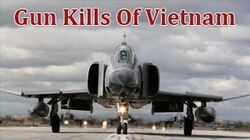
Dogfight Series - Gun Kills of Vietnam - Full Documentary
Dogfight Series-Gun Kills of Vietnam - Full Documentary (including McDonnell Douglas F 4 Phantom II).
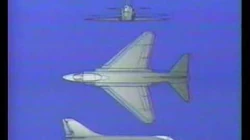
McDonnell Douglas F-4 Phantom II
The McDonnell Douglas F-4 Phantom II Fighter Bomber Jet.
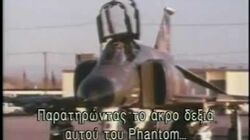
McDonnell Douglas F 4 Phantom II documentary (Greek subs)
McDonnell Douglas F 4 Phantom II documentary (Greek subs).
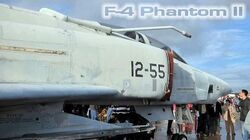
McDonnell Douglas F 4 Phantom II (Details)
McDonnell Douglas F 4 Phantom II Fighter Bomber Jet (Details).

The F-4 "Phantom II" Supersonic Fighter Bomber Jet - McDonnell Douglas Documentary 1964
The F-4 "Phantom II" Supersonic Fighter / Bomber Jet - McDonnell Douglas Documentary 1964.
Images[]
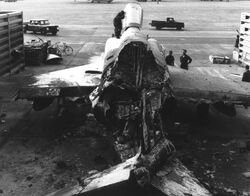
A USAF RF-4C Phantom II destroyed during the enemy attack against Tan Son Nhut during the February 18, 1968 rocket attack which also destroyed the base chapel during 1968.
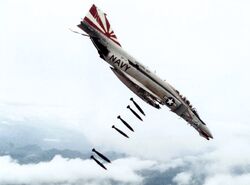
8 of 28 A U.S. Navy F-4B from VF-111 dropping bombs over Vietnam, 25 November 1971.
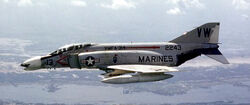
A U.S. Marine F-4B Phantom II of fighter-attack squadron VMFA-314, the Black Knights, flying over South Vietnam in September 1968.
